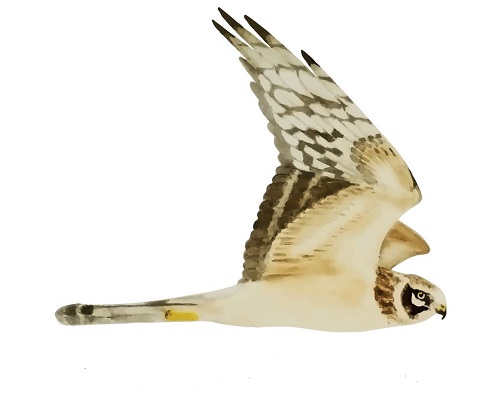Her på Skagen Fuglestations blog bringes korte nyheder i dagbogsformat om hændelser på fuglestationen.
Se indlæg fra måned: jan. (2)feb. (3)mar. (31)apr. (30)maj (31)juni (30)juli (31)aug. (31)sept. (30)okt. (31)nov. (30)dec. (9)
Sabine’s Gulls for everyone
The title is a little misleading as we did not see multiple Sabine’s Gulls (Sabinemåge) but we did get nice looks at one that was seen well by all. Florian, and I (Miles) went to do the migration count at Worlds End III. As Simon had predicted, there was a lot of passerine movement, with many migrating or attempting to migrate. There was not as much waterbird movement but just as we started the second hour, Knud called out “Sabine’s Gull!” It was a first-year bird, flying northwest, quite close to the shore. Florian immediately called it out on Zello, so that the others at the ringing could see it. They all got looks and it was a lifer for Gabriel! Simon was quite pleased and will not be quite so disappointed to miss the migration count for the next few days. We did not see anything else as exciting, but did see some Common Shelducks (Gravand), Little Gulls (Dværgmåge), which are cool for me and had a second Little Stint (Dværgryle) join the other on the pond.
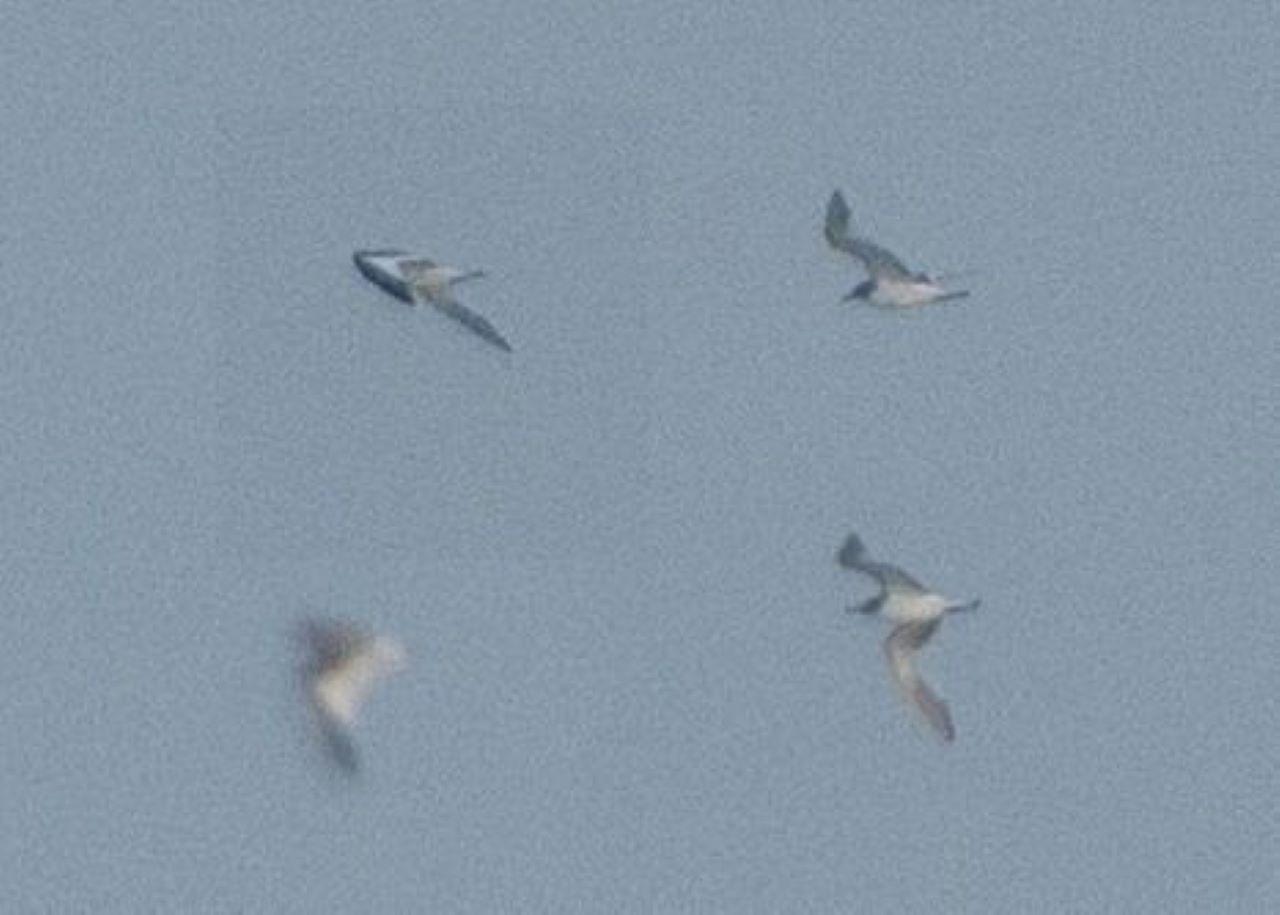
Documentation shots of today's first-year Sabine's Gull. Photos by Florian.
Gabriel and Amira opened the nets at Kabeltromlen this morning and were later joined by Simon. There were not as many birds as the last two days, but plenty of individuals and species, including 20 Eurasian Blackcaps (Munk) and 13 Common Chiffchaffs (Gransanger). In total they had 68 individuals across 10 species.
At Jennes Sø Michael also had a good morning with a high variation of species. Among those a Crested Tit (Topmejse) and a Pied Flycatcher (Broget Fluesnapper).
Our guests Søren and Karen Marie left this morning. The house is quite quiet as Janna is gone, and Sarah is away for the weekend, but new guests arrive tomorrow.
I have been out swimming everyday that I have been here and it’s quite refreshing. I may try to go everyday but we will see how my resolve holds up in the later months. I got some running shoes in town yesterday and I think Sarah, Amira and I are going to make a running “club.”
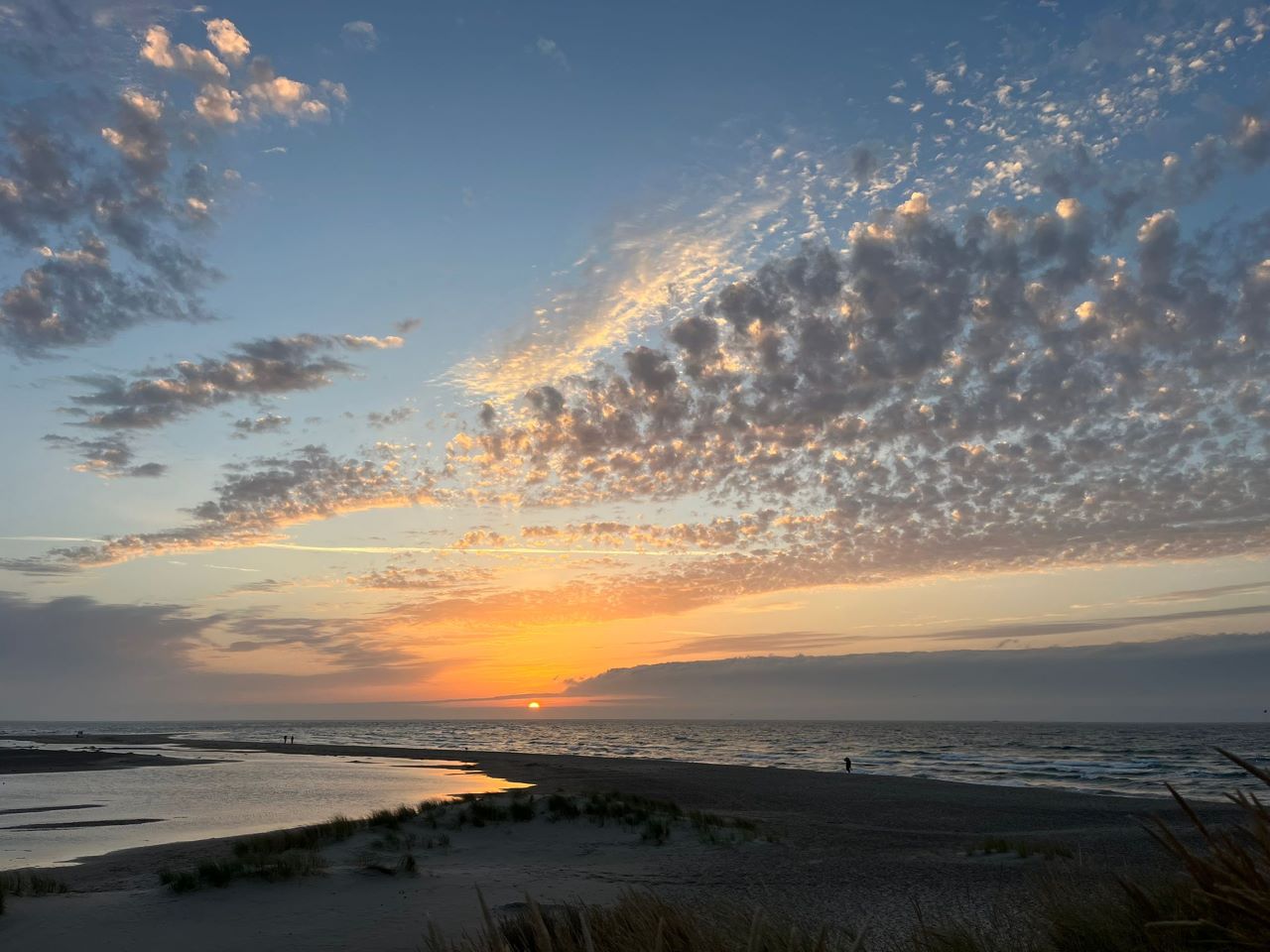
The beautiful sunrise this morning at Worlds End III. Photo by Miles.
The forecast for tomorrow is uncertain, we may get some rain, which would make us delay the count and ringing. We have been discussing night catching for waders and Simon thinks tomorrow night could be good. There has been good diversity of resting waders at the migration count, so hopefully they stick around.
Ringing (Kabeltromlen):
Blåmejse 3
Dompap, Lille (ssp. europaea) 1
Gransanger 13
Gærdesmutte 8
Jernspurv 2
Munk 20
Rødhals 18
Rødstjert 1
Rørspurv 1
Sortmejse 1
Total 68
Ringing (Jennes Sø):
Gærdesmutte 3
Jernspurv 1
Rødhals 7
Rørsanger 1
Munk 1
Gransanger 3
Løvsanger 3
Fuglekonge 2
Broget Fluesnapper 1
Topmejse 1
Sortmejse 2
Blåmejse 9
Grønsisken 5
Stor Gråsisken 1
Lille Gråsisken 4
Lille Dompap 2
Total: 46
Highlights from Worlds End III:
Sabine's Gull (Sabinemåge)
Links to todays observations in Dofbasen from the Skagen area
People: Gabriel Axelsson, Florian Hatt, Miles Scheuering, Amira Nuseibeh, Simon Christiansen, Knud Pedersen, Michael Ancher.
Redpolls and the Lucky Red Mushroom
Today was only my fourth day at the station but it’s been brilliant so far and I can’t wait to spend the next two and a half months here! Janna and I (Amira) went to open up the nets at Kabeltromlen this morning and were soon joined by Sarah and her friend David for a great morning of ringing. Although there were fewer birds in the nets than the last couple of days, we still managed to catch 15 different species and over 60 birds in total, including a Great Spotted Woodpecker (Stor Flagspætte) just as we were about to pack up. It was also nice for Sarah’s friend, David, to learn about our bird ringing work and have the opportunity to release some of the birds we had ringed.
My favourite bird species today was the Lesser Redpoll (Lille Gråsisken), a tiny but beautiful finch which loves to hang upside down to feed on the seeds of trees, especially Birch and Alder. They can even eat up to 42% of their body weight in seeds in one day! Both male and female Redpolls have a small red patch on their forehead, but earlier on in Spring, in the breeding season, males also have a pink coloured chest. They are also very sociable birds and often travel in large and noisy flocks which we have seen flying over every day recently. So listen out for their chattering calls this time of year and in the Winter too!
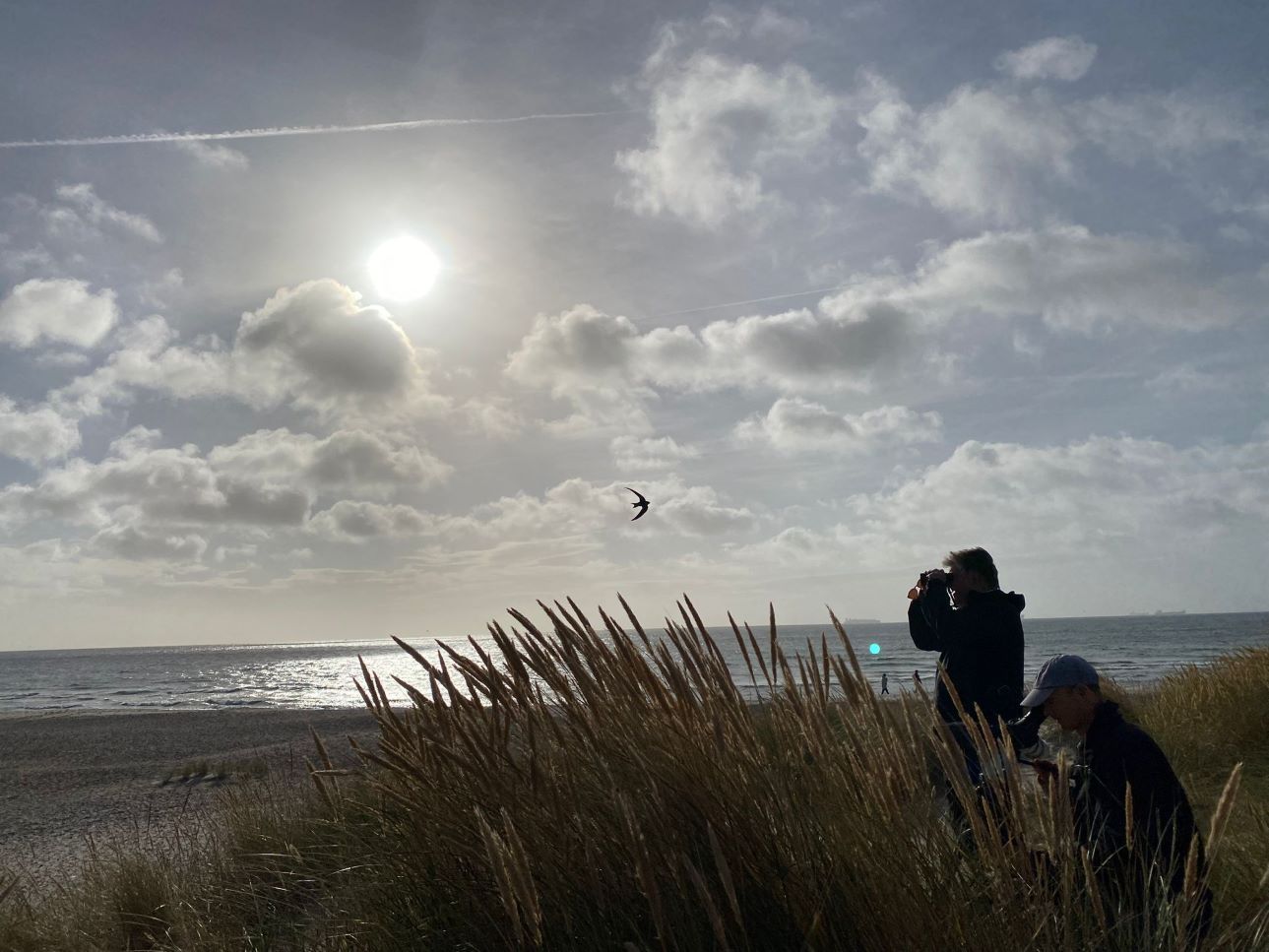
The "last" Swift (Mursejler) of the year
The observers also had a fantastic morning carrying out their migration count at World’s End 3. Their highlights were a Black Tern (Sortterne), Long-tailed Skua (Lille Kjove), Great Skua (Storkjove), Shag (Topskarv) and maybe even the last Swift (Mursejler) of the year, although we have been saying that every day for the last two weeks. Simon guesses the last swift will pass here in November so we will see if he is right!
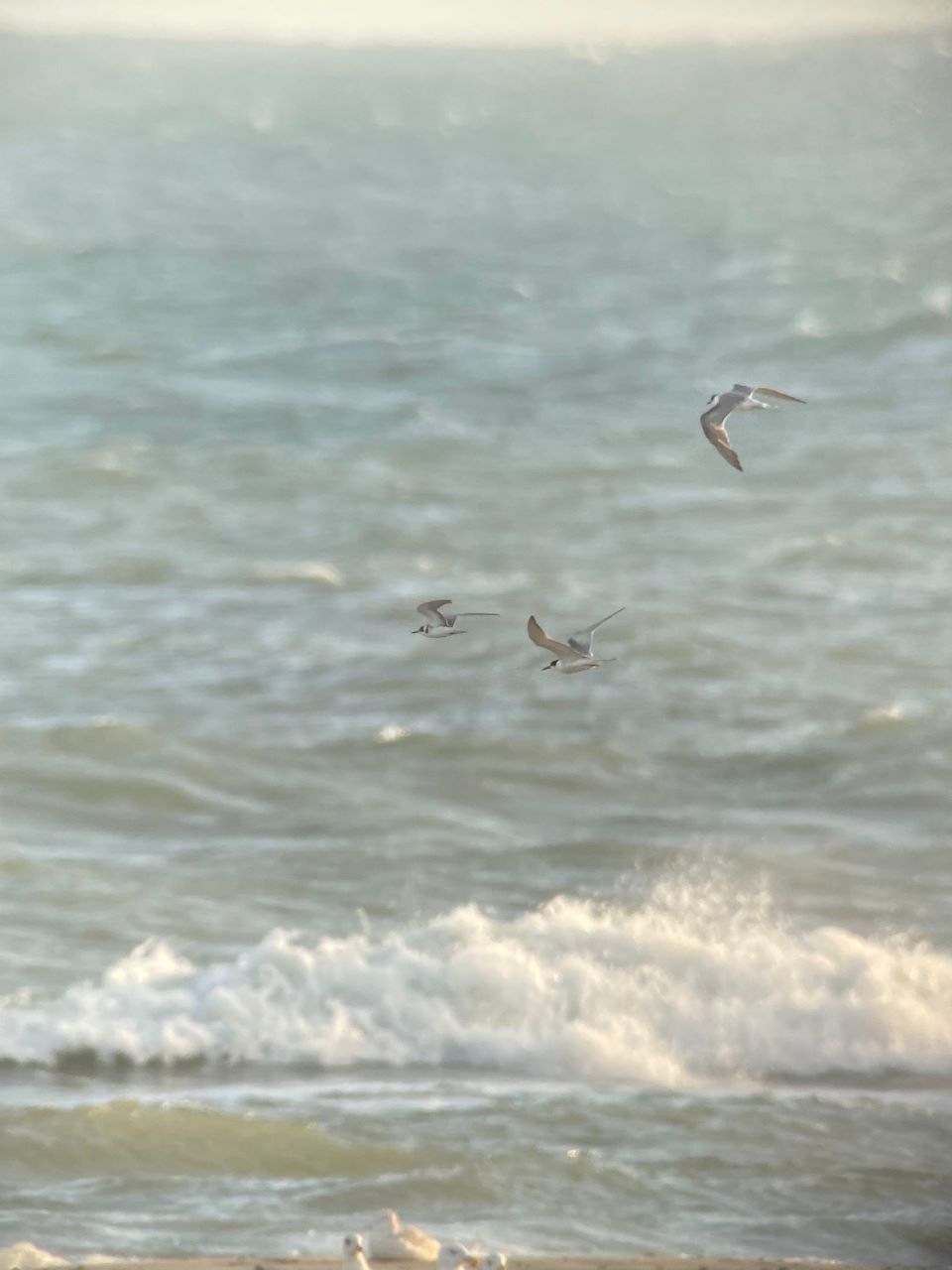
One Black Tern (Sortterne) and two Common Terns (Fjordterne)
We all arrived back from ringing and observing for lunchtime and then had a relaxing afternoon doing some data entry, birdwatching, and most importantly having a nap. I went for a walk to my new favourite birdwatching spot at Ellekrattet woods and found a big mixed flock of small passerines including at least 10 Goldcrest (Fuglekonge), and also a Sparrowhawk flashed by. I particularly love this woodland because of all the other non-bird species you can find here. Everywhere you look there are fungi (svamp.), of all different shapes, sizes and colours. Although Fly Agarics (Fluesvamp/Amanita muscaria) (photo below) are poisonous mushrooms, they are often seen as symbols of good luck, so I’m excited to see if this means we will have some especially good birds tomorrow for our ringing and migration counts!
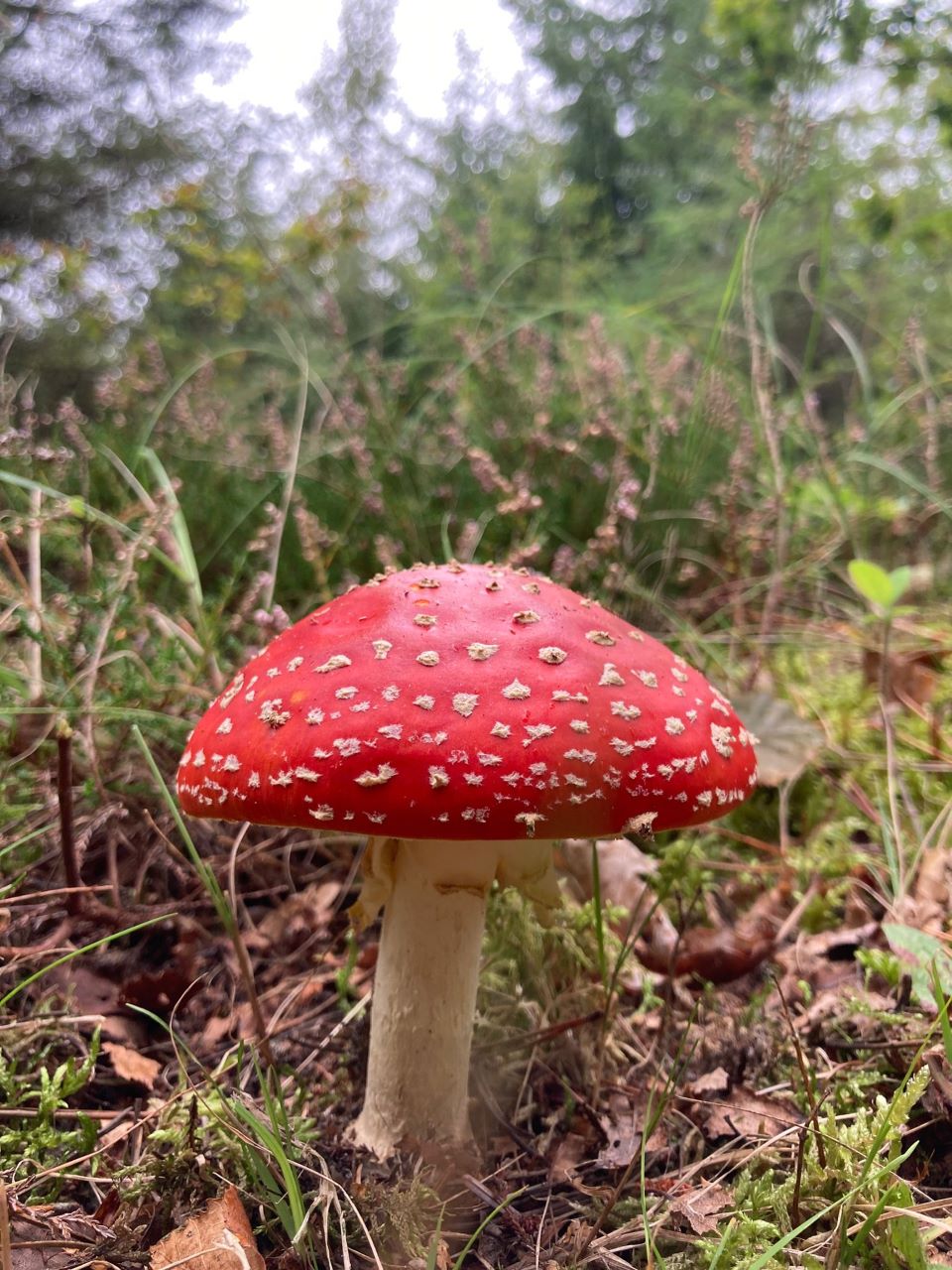
Fly Agaric mushroom (Fluesvamp)
Ringing (Kabeltromlen):
Stor Flagspætte 1
Lille Gråsisken 4
Lille Dompap 1
Rødstjert 2
Musvit 1
Fuglekonge 4
Vogfinke 5
Rørspurv 2
Gransanger 10
Jernspruv 11
Rødhals 9
Sortmejse 1
Gæardesmutte 2
Blåmejse 1
Munk 7
Ringing (Jennes Sø)
Gæardesmutte 1
Rødhals 6
Munk 1
Gransanger 11
Løvsanger 1
Fuglekonge 4
Topmejse 2
Sortmejse 1
Blåmejse 14
Musvit 4
Bogfinke 2
Lille Gråsisken 9
Lille Dompap 1
Total new birds: 118
Highlights from World’s End 3:
Black Tern (Sortterne)
Long-tailed Skua (Lille Kjove)
Great Skua (Storkjove)
European Shag (Topskarv)
Link to today’s observations in DOFbasen for observers in the area
People: Janna Ouedraogo, Sarah Partridge, Gabriel Axelsson, Florian Hatt, Miles Scheuering, Amira Nuseibeh, Simon Christiansen, Knud Pedersen and our guests David, and Søren and Karen Marie Leth-Nissen.
Great Skua Day
This night it was raining. When the rain stopped, the ringing crew- Sarah, Gabriel and Amira- headed out to open the nets. After the rain, many birds were active and the ringers had a busy day. Especially in the first round the nets were crowded. Sarah was very happy about the many Robins (Rødhals). 26 of them were caught today so that was the top species during ringing. In total 95 birds were ringed today- a record for at least the last weeks. Also, the variety of birds in the nets was remarkable. Goldcrests (Fuglekonge), Wrens (Gæardesmutte), Pied Flycatchers (Broget Fluesnapper)… Amira came back very happy and told us about the first Redpoll (Lille Gråsisken) she had seen in the hand.
Nevertheless, I was very happy to be at the observation today. We had a great migration day! When we headed out this morning, we were motivated to see some cool birds, but we did not know what a day would follow. The count started with many Kittiwakes (Ride) that came in from Kattegat. We used the first minutes to watch the many Waders that were hanging out in a puddle at the beach. After an hour, Miles spotted a strange looking gull. A Sabines Gull (Sabinemåge)!! Under good light conditions we were able to follow this beautiful bird for a longer time. It sat down on the water and then moved on to Northwest. Later in the day, we heard on Zello that it was seen again not far from here.
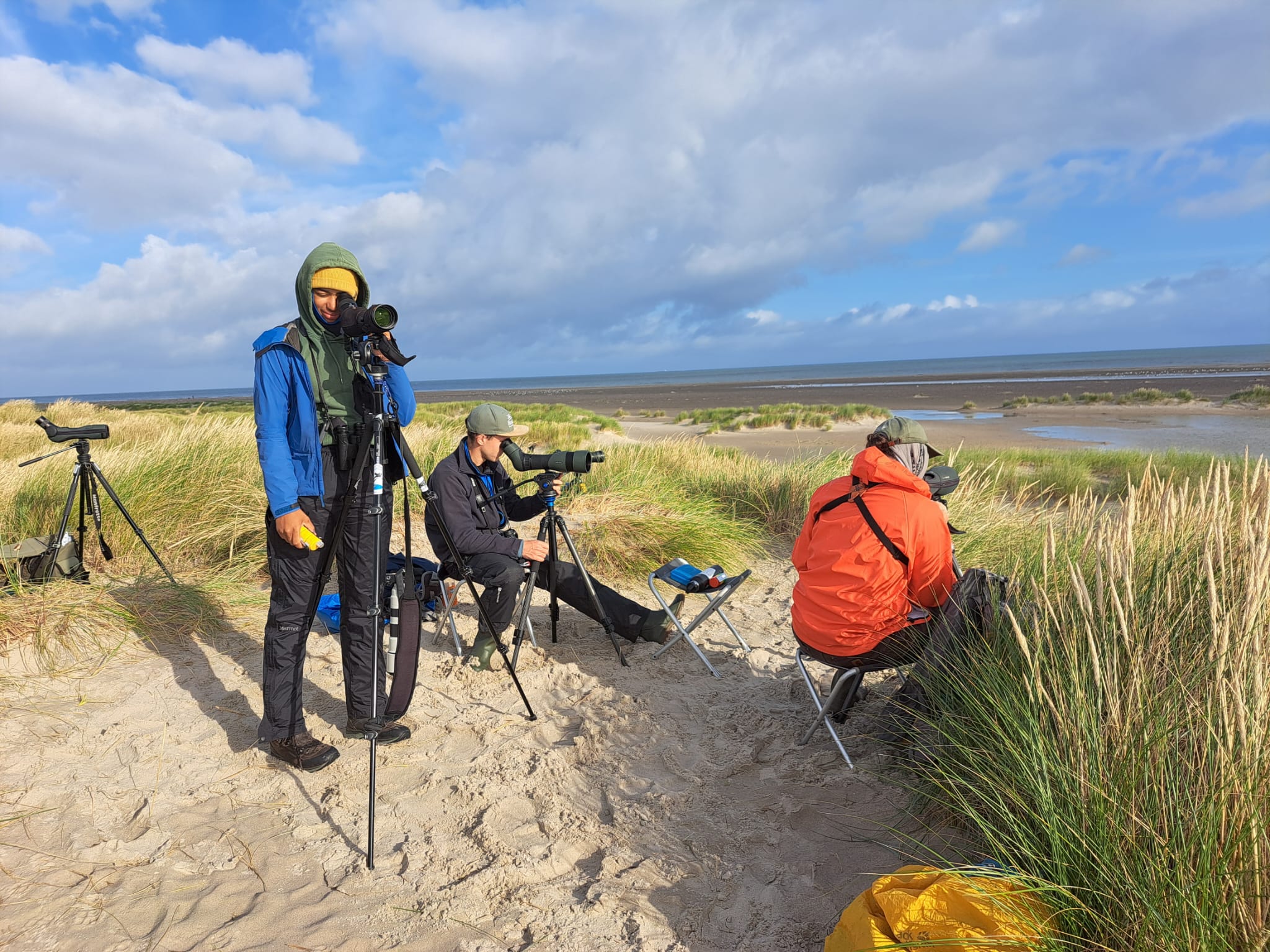 The very concentrated, very happy counting team
The very concentrated, very happy counting team
We just recovered from the great Sabines Gull sighting, when Knud called out a Sooty Shearwater (Sodfarvet Skråpe) that flew by relatively close. Flo and I had just seen our first one some days earlier- very far out. Therefore, it was very nice to see one close enough to see the lighter underwings and some other details. We could follow the bird for a longer time- going up and down, surfing in the waves and showing its flying abilities. And this one should not stay the only Shearwater for the day. In total we saw four of these beautiful birds. Probably tomorrow the Great Shearwater (Storskråpe) that is at the Moment resting at the Swedish side of Kattegat will follow. At the ringing, the others were able to see two of the four Shearwaters.
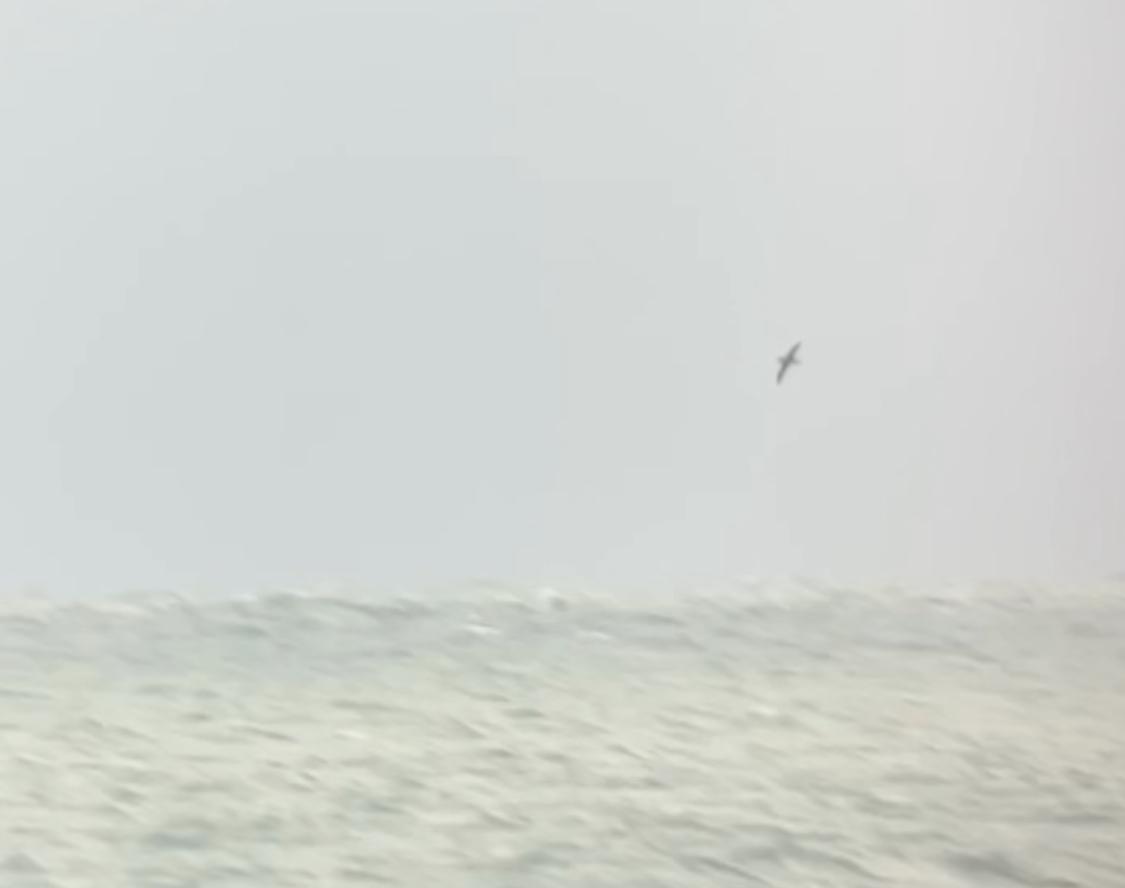
Record shot of the Sooty
In general, there was not much time between the sightings of some special birds. When no Sabine Gulls (Sabinemåge) or Sooty Shearwaters (Sodfarvet Skråpe) flew by, a Skua (Kjove) did. We assume that we saw the same individuals several times. However, at least four different individuals were in the area and we could see them quite often. Besides the Arctic Skua (Almindelig Kjove) a Great Skua (Storkjove) moved with heavy wingbeats through our field of view. In the end of the count, a Merlin (Dværgfalk) flew over- always a nice bird. In the last hour, we heard a Red-Throated-Pipit (Rødstrubet Piber) flying over. We had talked about this bird the past days and it was a highlight to hear one in the field. After the end of the count, we stayed a bit to use the good conditions. Later on, I wanted to leave to check some trees in the inland for passerines. Every time when I started to pack up my scope, another nice bird flew by and I had to stay. Shortly after I left, the others saw a nice but very far out Long-Tailed-Skua (Lille Kjove).
What a Day! In the inland, I made a slight detour to Skarvsøen- always a good place. There I heard a Rock Pipit (Skærpiber) flying over and some Finches. A small checkup of Ellekrattet revealed no birds, so I went home.
In the afternoon we went for a swim and after that, it was time for Sarah to pick up her friend David in Skagen. Meanwhile, the others of us ate some Apple Crumble and prepared for the rest of the day. Shortly after that, Amira went on a walk through the heath to Batteriskoven. Flo, Miles and I started our way to Skagen to meet Sarah and David. On our way we saw Simon and Gabriel, giving a Tour to some volunteers from Thy. We went by and stopped for a longer time at Batteriskoven. There we could see some groups of passerines, hiding from the wind. We continued our way and met up with Sarah and David at a pub in Skagen. It was very funny over there and also interesting to talk a bit less about birds and a bit more about politics and other non-birding topics. On our way back, we almost flew with strong tailwind and Flo, Miles and I checked Batteriskoven again. When we came back to the station, the guests Karen Marie and Søren had cooked some nice dinner and we had a fun and vivid dining with ten people around the table.
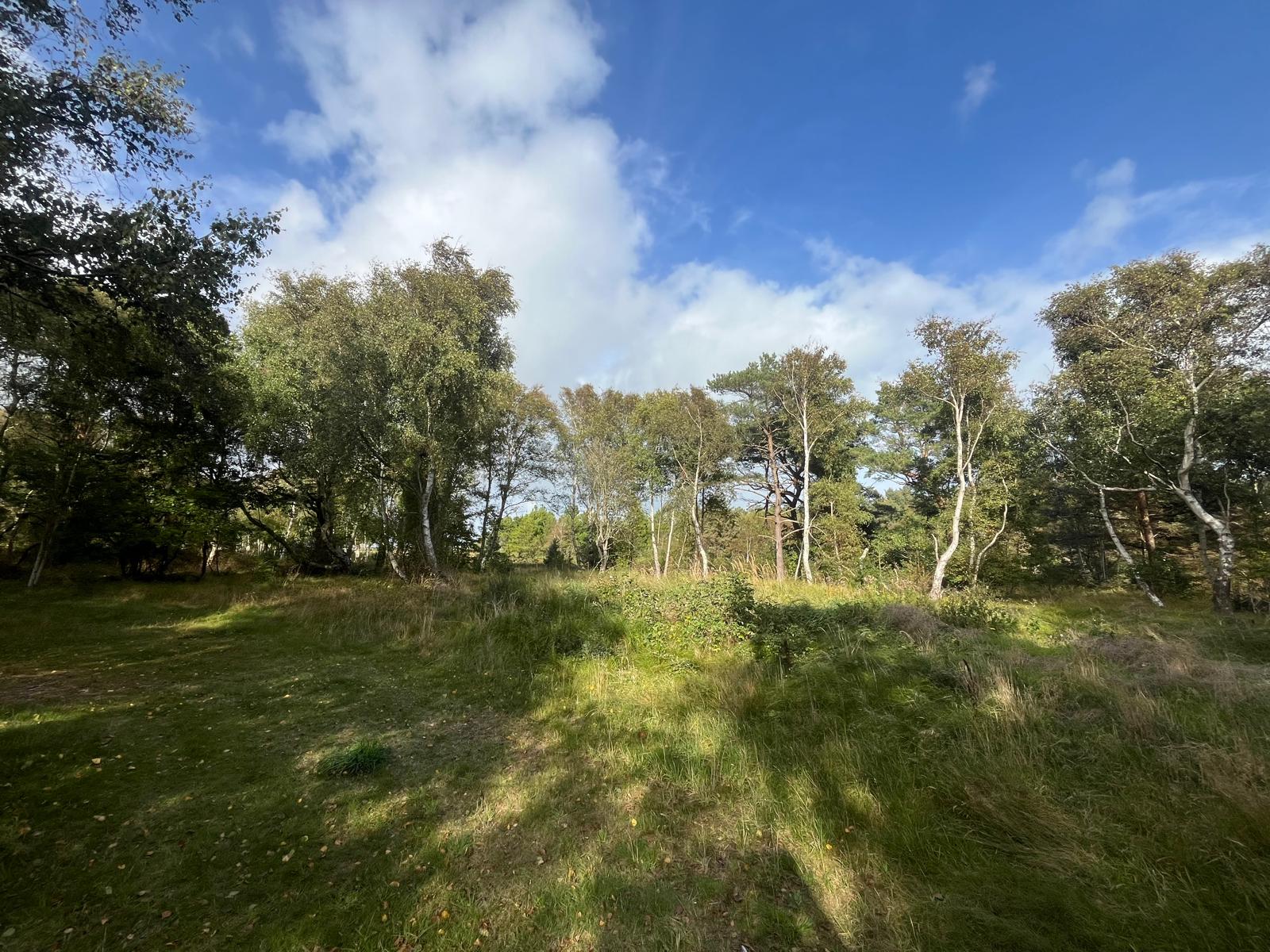 Landscape around Batteriskoven
Landscape around Batteriskoven
My last day here passed so quickly. It was certainly one of the best migration days and I really enjoyed it. I can´t believe that I am leaving tomorrow. The time up here is moving in a strange way. The days are so entertaining and fly by. At the same time, looking back, so much has happened. We saw many cool birds, talked about interesting topics, played games, went on a swim and had a good time. It was interesting to see the station in autumn and meet so many cool people here. I learned a lot and will really miss it. So I have to come back soon :).
Vi ses
Ringing (Kabeltromlen):
Rødhals 26
Lille Gråsisken 2
Gæardesmutte 3
Gærdesanger 1
Rødstjert 4
Jernspurv 11
Sortmejse 8
Broget Fluesnapper 1
Munk 20
Røspurv 1
Havesanger 1
Lille Dompap 3
Bogfinke 1
Blåmejse 1
Fuglekonge 2
Gransanger 10
Total new birds: 95
Highlights from World’s End 3:
Sabine Gull (Sabinemåge)
Sooty Shearwater (Sodfarvet Skråpe) 4
Red-Throated-Pipit (Rødstrubet Piber)
Long-Tailed-Skua (Lille Kjove)
Great Skua (Storkjove)
Link to todays observations in Dofbasen from the Skagen area
People: Gabriel Axelsson, Florian Hatt, Janna Ouedraogo, Sarah Partridge, Amira Nuseibeh, Miles Scheuering, Simon Christiansen, Knud Pedersen and our guests Søren and Karen Marie Leth-Nissen, David
stinking, foul gull
Today was windy so the whole group got to go observing at World’s End III. We made sure everyone was fitted with bikes and scopes and everything we need, and after a nice breakfast together we all headed over where we met Knud. Karen Marie and Søren also joined us a little later. It was loud in the wind and it was very cute with everyone shouting birds at each other over the wind. It was a pretty busy day for migration, with many Lomvie (Guillemots) and Alk (Razorbills), Ride (Kittiwakes), Sandløber, and some Mallemuk (Fulmars) who I have not seen for a few days now. A bit of interest about Fulmars—where does this word come from? They shear water too, but have a different name. It comes from old Norse ‘Full’ (stinking, foul) + ‘mar’ (gull), named for the extremely smelly oil they project when threatened. This oil can be highly toxic to predators because it removes the waterproofing from an attacker’s feathers, causing them to eventually die. The Danish "mallemuk" I am not sure about; Simon said a Malle is 'kind of a fish' but I think there is more to the story. Does anyone know? Please tell us!
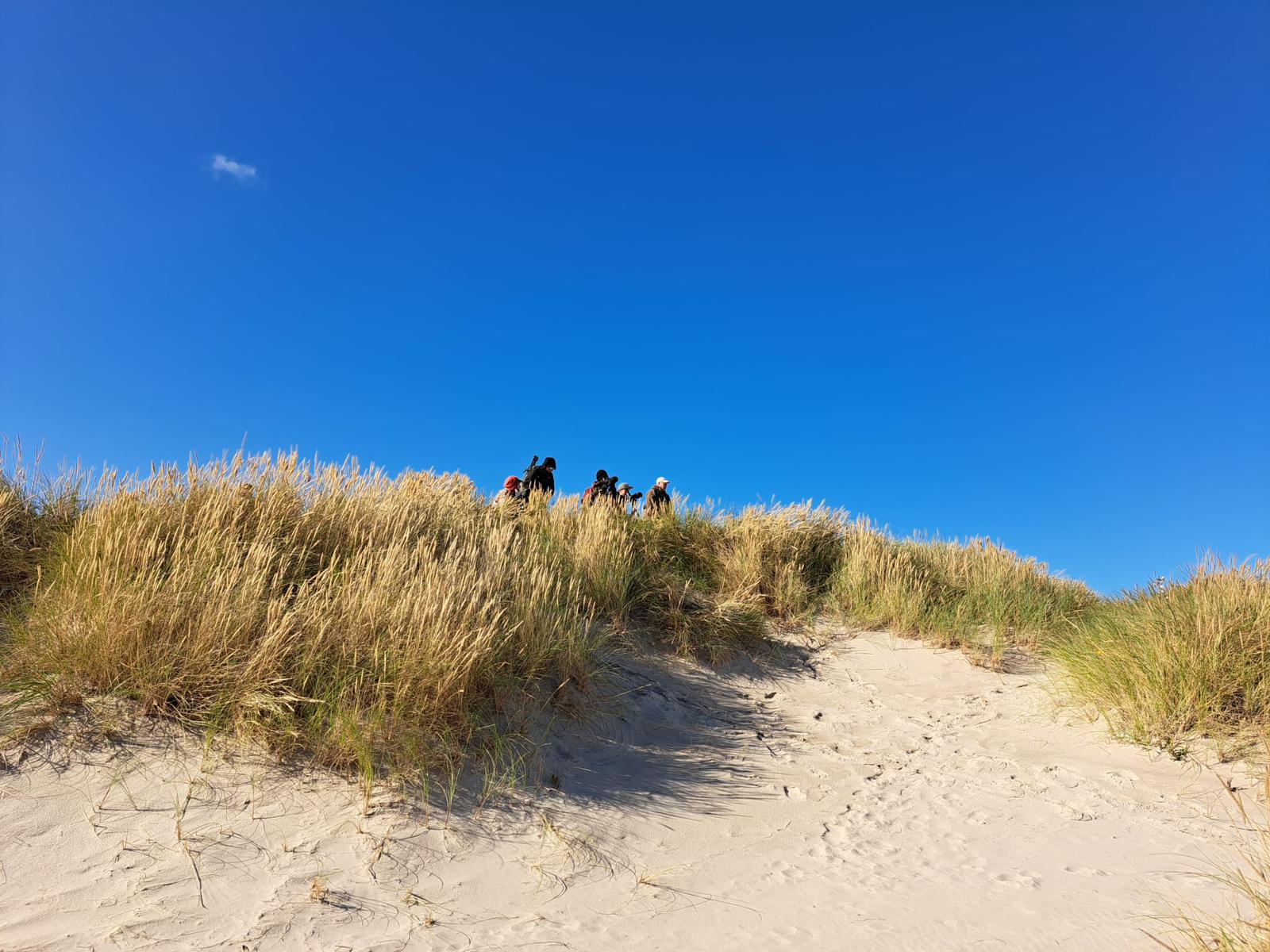
It was also nice to see an Arctic skua (Almindelig Kjove) very close to us flying in from Kattegat, and then shortly after a Long-tailed skua (Lille kjove). I was excited to see two Bar-tailed godwits (Lille Kobbersneppe) relaxing on the beach with some gulls. We also saw a sooty shearwater (Sodfarvet skråpe) although it was quite far out. “SOOTY SHEARWATER” was shouted down the row of observers several times to make sure no one would miss it!
After the count, I went to read some gull rings before the flock got flushed, and Janna and Amira went to admire the large quantity of Ederfugl resting in Kattegat. Some of us then went for a very cold swim before lunch, and we were surprised with a delicious cake waiting for us in the apartment. When we found out it was Simon who magnanimously brought the cake we all thanked him profusely and he said without looking up “now you can remove ‘eat cake’ from the To-do list.” But you can never eat enough cake.
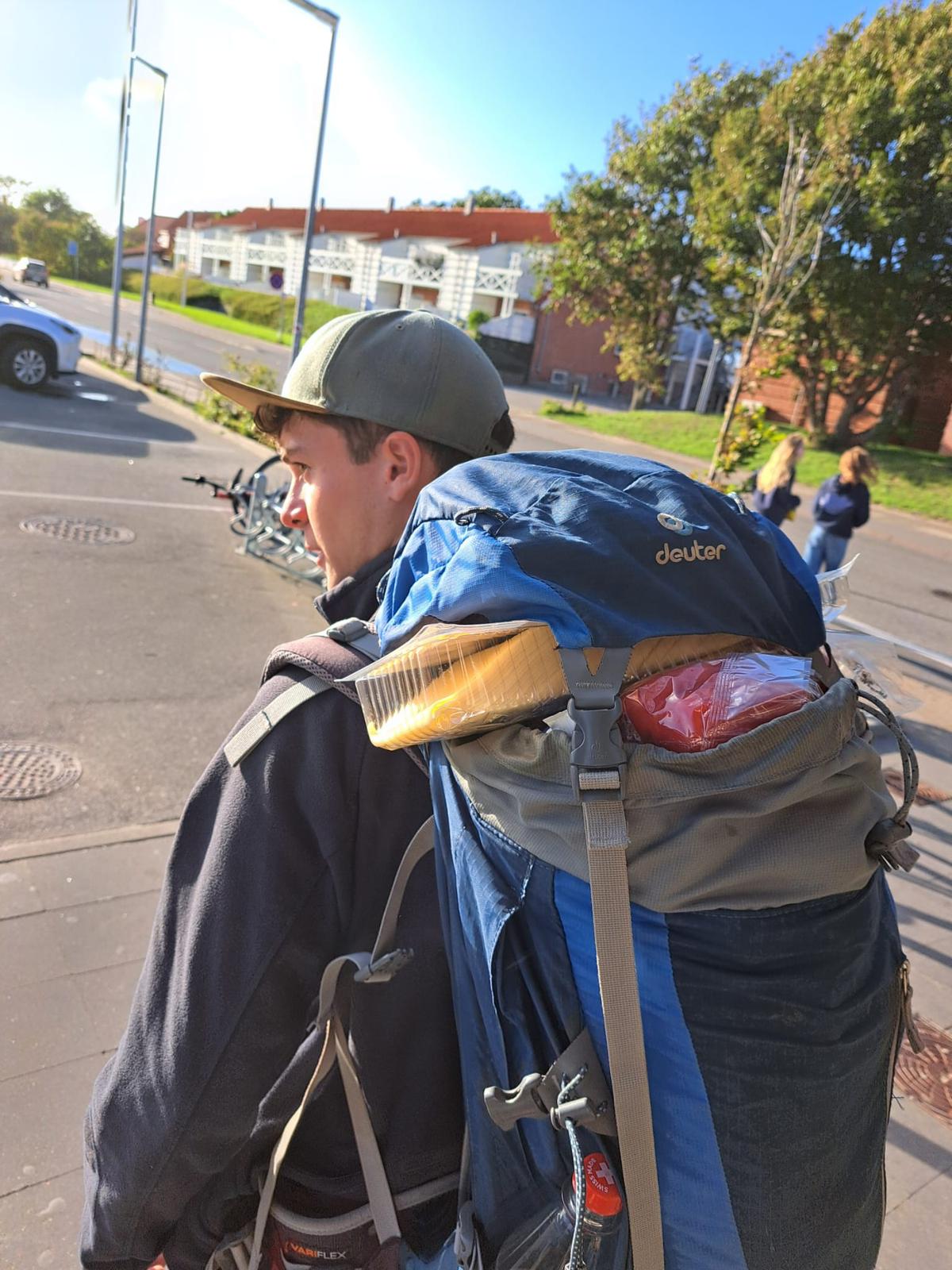
After lunch Karen Marie kindly brought us to Skarvsøen to finally collect the poor neglected CES table, which has certainly seen better days, but happily many spiders have found a home to build their nests so the table is not being wasted. There we did a bit of birdwatching, and although we did not see the Citrine Wagtail (citronvipstjert) again (because we forgot to bring Florian the Citrine magnet), we did see a spoonbill (Skestork) flying overhead and a juvenile water rail (Vandrikse) which I always love, and Florian saw a Cuckoo (Gøg) without us. Now we do some office tasks while Florian cooks us a nice-smelling ratatouille. But no dessert because we are already out of cake!

Highlights from World's End III
Sodfarvet skråpe
Lille kjove
Mallemuk
Lille Kobbersneppe
Toppet Skallesluger
Ride
Link to today's observations in DOFbasen.
People: Gabriel Axelsson, Florian Hatt, Janna Ouedraogo, Sarah Partridge, Amira Nuseibeh, Miles Scheuering, Simon Christiansen, Knud Pedersen and our guests Søren and Karen Marie Leth-Nissen
Loads of feisty Blue Tits
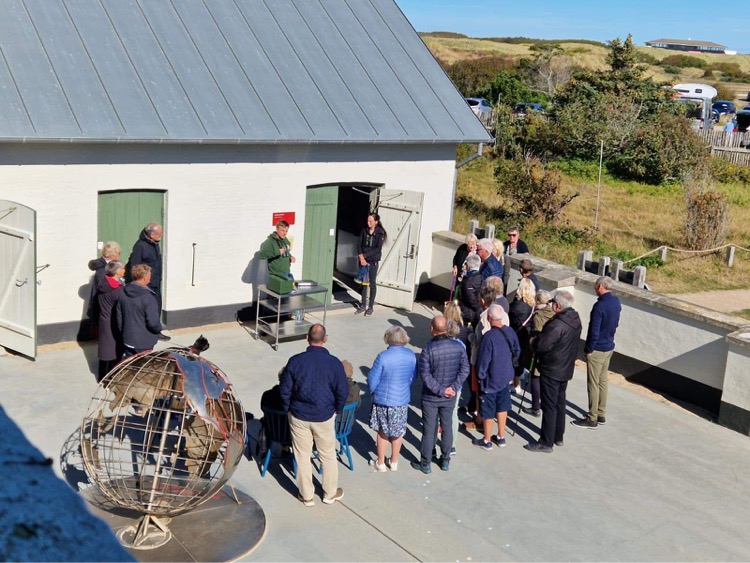
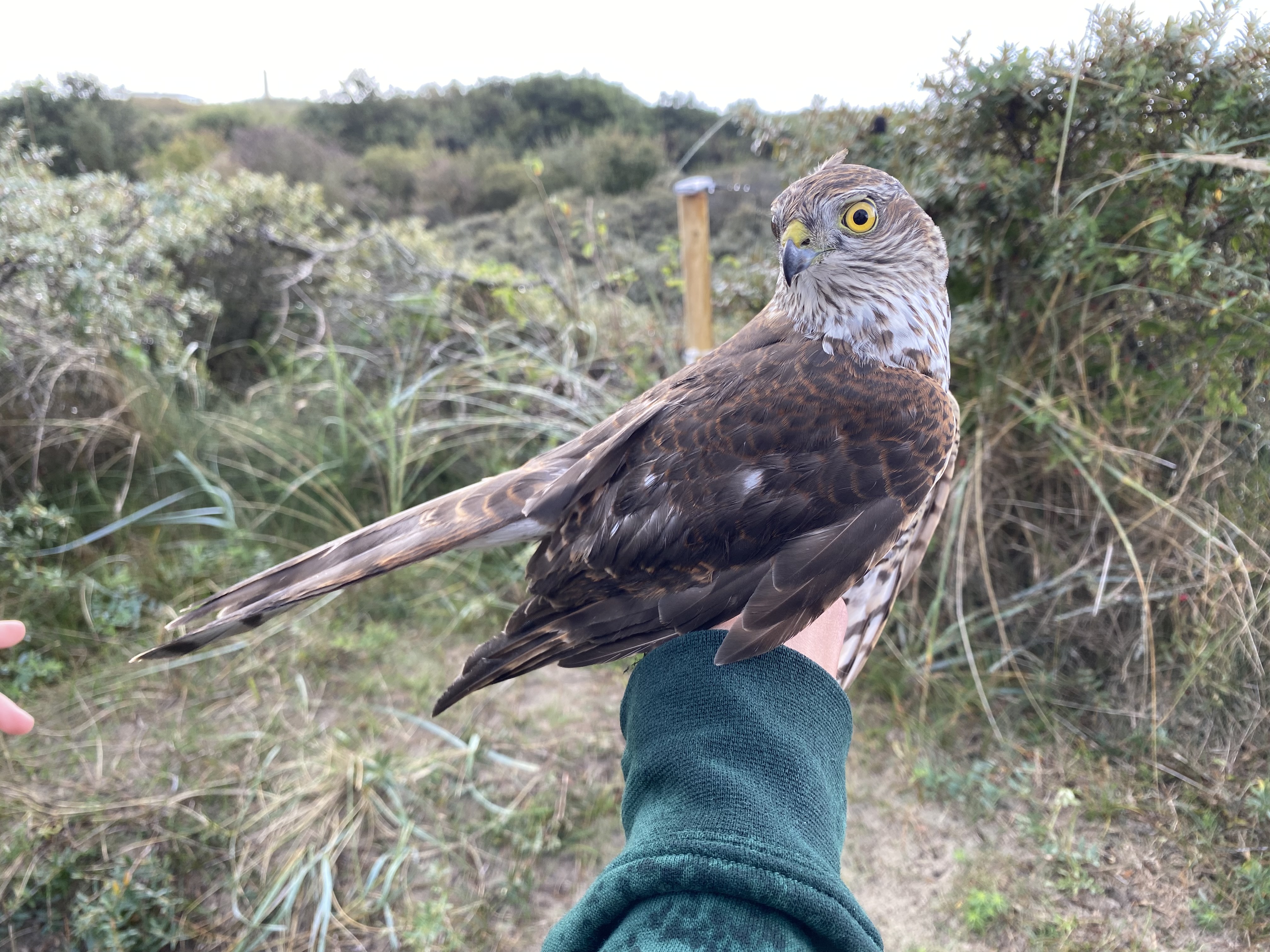
People: Gabriel Axelsson, Florian Hatt, Janna Ouedraogo, Sarah Partridge, Amira Nuseibeh, Miles Scheuering, Simon Christiansen, Knud Pedersen and our guests Søren and Karen Marie Leth-Nissen
Calm day with a nice surprise
Gabriel and Sarah did another night shift to keep an eye on the storm petrel and nightjar nets for us. The nets had to be checked again for a last round late in the night. They moved along the beach, focused on the nets, trying to detect every movement in there. Did you see that? There's a bird in the net! We got a Storm petrel (stormsvale)! Gabriel and Sarah sped up, getting closer to the net. Wow, there it is! But wait, it looks a bit different. No, this isn't a Storm petrel. It's a cute little Robin (Rødhals). Between the joy of finding a bird and the disappointment that it wasn't a Storm petrel, the Robin was of course measured, ringed and released again. Have a good time, little friend!
I heard this story in the morning after I woke up tired and the others had just returned from their last round of net checking. They went to bed, while Janna, Oscar and I went to Worlds End III. There was no ringing today at Kabeltromlen due to the strong wind. Michael Ancher had slightly better wind shelter in Jennes Sø, where he saw a nightjar (Natravn) in the net in the morning! Unfortunately, the bird flew out again when he tried to approach it.
During the migration count, we had a very quiet morning with little bird activity. However, this gave us more time to observe and study the birds that were here. For example the Kittiwakes (Ride) are always nice to seee. Twice, an unidentified skua (Kjove sp.) briefly appeared in the distance before immediately disappearing again among the waves. The same thing happened with a possible Fulmar (Mallemuk), also extremely far away.
Beautiful sunrise at Verdens Ende III
Later, our guests Karen Marie and Søren joined us for the migration count. Suddenly, a Goldeneye (Hvinand) flew in. We haven’t seen any of them the last two weeks. Even though it was difficult to see it among the Common Scoters (Sortand) and kept flying around, we had enough time to show it to our guests. Unfortunately, a heavy rain shower was approaching, so we couldn't count the last 1.5 hours and headed home before the rain started. Noon passed, some took a nap and others did some relaxed work. Sarah, Janna and I went for a quick swim despite the strong waves and wind.
We had to say goodbye to Oscar, who is already leaving after just one week. Even though it was only a short stay, it was such a nice time! He now has to focus on his master's thesis, in which he will work on the colours of bee-eaters, among other things.
Afterwards, Janna, Gabriel and I walked from the Sandormen Track to Skarvsøen. There were several passerines active in the bushes, which is always exciting to watch. At the small lake, we spotted three Spotted redshanks (Sortklire) flying around and calling. Suddenly, we heard a sharp call of a flying wagtail. As I had studied the calls in detail just a few days ago, I immediately noticed that these calls sound very much like a Citrine wagtail (Citronvipstjert)! Janna managed to see the bird landing, so we got some nice views of it sitting in the vegetation. That definitely deserved a high five between all of us! It was again a 1K bird so maybe the same as some days ago at Grenen.
Juvenile Citrine Wagtail (Citronvipstjert) at Skarvsøen, what a nice surprise!
We came a bit late to our evening meeting and then had a delicious dinner together with our guests and the new volunteer Amira, who we had welcomed just before.
No ringing today at Kabeltromlen
Ringing (Jennes Sø)
Gransanger 1
Løvsanger 1
Blåmejse 7
Musvit 3
Gråsisken, Lille (ssp. cabaret) 6
Total 18
Highlights from todays observations
Citronvipstjert (at Skarvsøen)
Skægmejse (at Skarvsøen)
Today’s observations in Dofbasen from observers in the area
People: Gabriel Axelsson, Florian Hatt, Janna Ouedraogo, Sarah Partridge, Óscar Pachá Guerras, Amira Nuseibeh, Simon Christiansen, Michael Ancher and our guests Søren and Karen Marie
The eye of the storm
When we wanted to leave for today’s count, Sarah and Selina came already back from Kabeltromlen. They were pretty wet and did not open the nets because of a rain shower. Flo, Gabriel and I waited before the heaviest rain had stopped and headed then out to find some interesting birds at worlds end 3. On our way there we could watch a gorgeous sunrise. So beautiful, that we forgot to take a picture, therefore you have to imagine it. Around the sun, the sky turned glowing red. This was surrounded by some darker clouds that broke up at certain parts and revealed some colourful sunbeams. When we arrived at the counting spot, a lightning appeared in the red. A rest of a thunderstorm that luckily passed by.
During the first two hours we found two adult Arctic Skuas (Almindelig Kjove)- one light and one dark morph. There I tried to see the characteristics Knud had told us for the examination of the age. Especially in the dark birds wing that was difficult. Shortly after the last Skua disappeared, a Merlin (Dværgfalk) flew in and sat down very cooperative on the beach. Besides that, the migration was calm. Therefore, we took some time to look closely on some birds. The light was very good and we could follow a beautiful young Kittiwake (Ride) that flew by close to the shore.
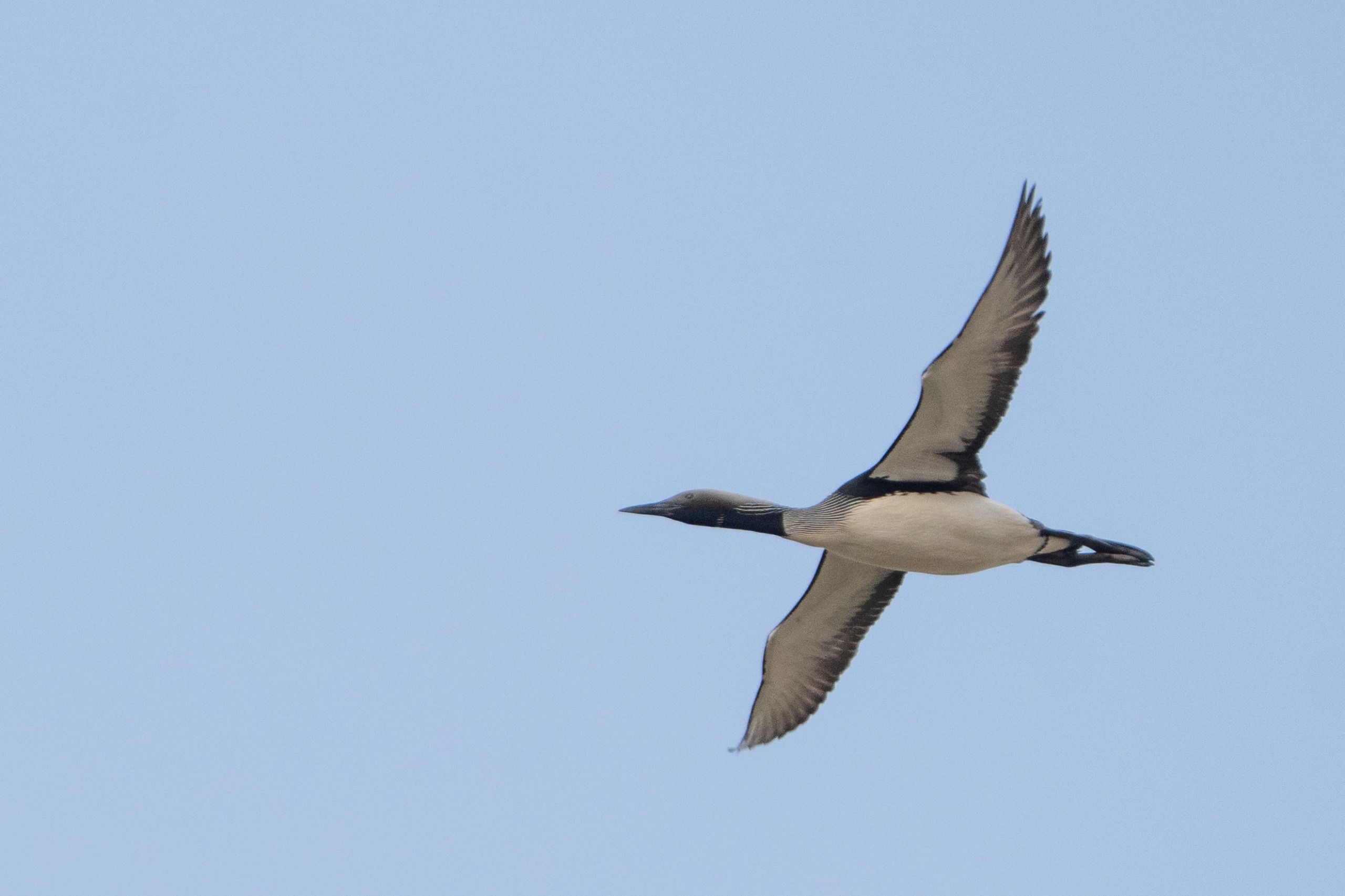 A Black Throated Diver in breeding plumage was flying directly above our heads
A Black Throated Diver in breeding plumage was flying directly above our heads
Sitting there, expecting nothing bad, the sky suddenly changed. The horizon disappeared between a wall of rain and we could just wait and watch the spectacle. After some time, I was not that amazed anymore and hoped the rain would stop soon. But it did not look like this. So, we had one hour of time to imagine all the birds we could see up here. When the rain began to decrease, Knud said, now there had to come a special bird. As a reward for our perseverance in the rain. No extremely rare bird showed up, but it was still nice to watch out a bit.
Meanwhile, Sarah, Selina and Óscar had set up the nets. During the shower they had to close them again and wait in a small tent for better conditions. When they opened again, many birds were flying into the nets. At this time, Gabriel and I arrived there after our count. Flo stayed a bit at the beach to take some pictures of Waders.
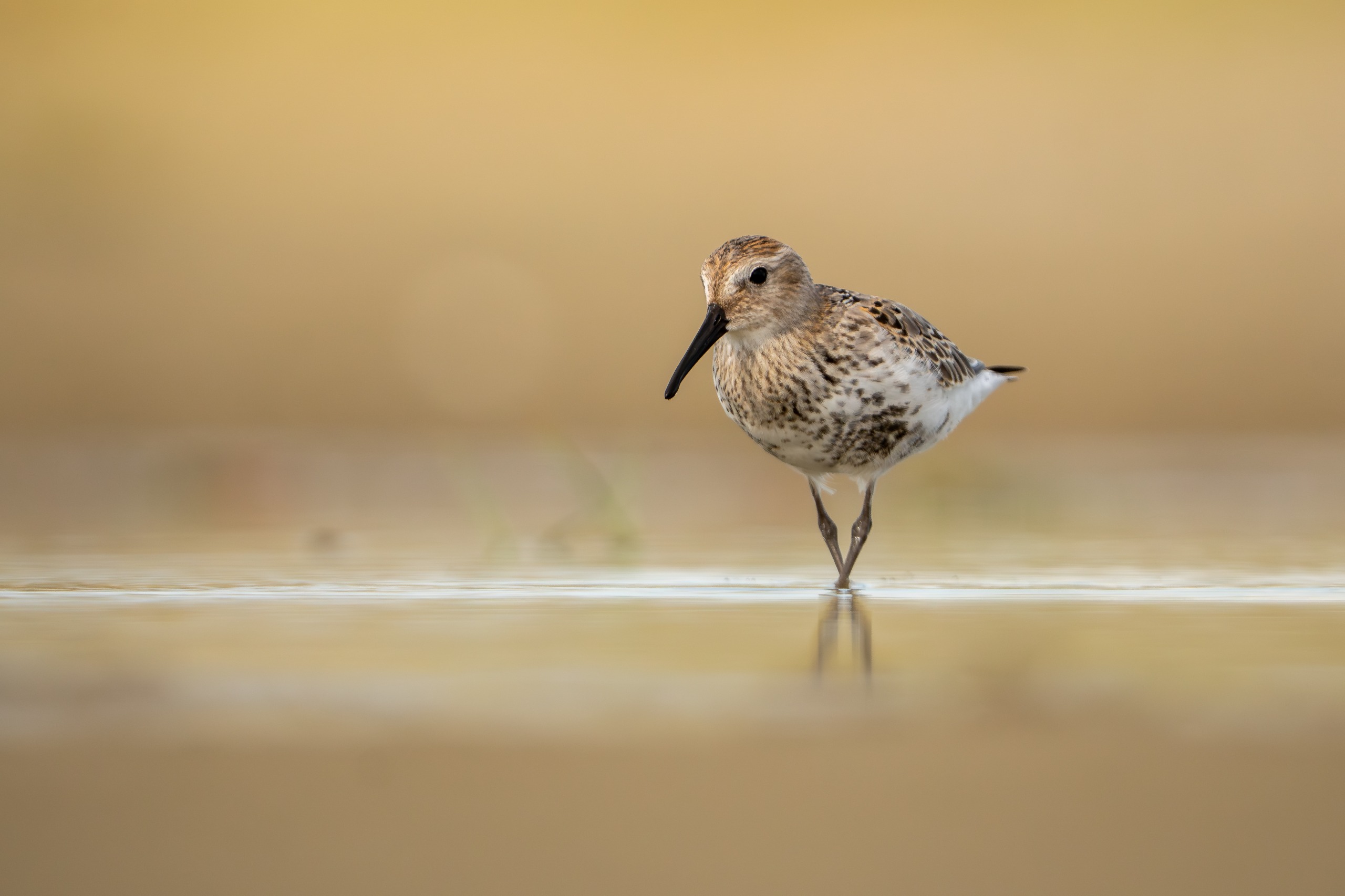
The waders liked the puddles that formed from the rain
Later on, when Flo joined the ringing, all six of us were there together. Shortly after all the birds were finished, Selina had to leave to reach her train back home. One last hug and then she went away. It was such a nice time with her and cool to see how fast she learned the ringing and handling of birds. Vi ses :).
After the ringing, we briefly went to Ellekrattet where we tried to find a Crested Tit (Topmejse) for Óscar. He has never seen this bird and up here in the coniferous forests is a good opportunity. Unfortunately, there was not much activity. Later on, we wanted to go birdwatching. When we looked at the radar, the others were not so motivated anymore. Therefore, I went out alone. I went to Skarvsøen and wondered, why I did this not earlier. It was very nice up there. Many passerines were in the bushes and several Swifts (Mursejler) were hanging around (maybe the last of the season- vi får se). I heard some Bearded Reedlings (Skægmejse) and my first Bramblings (Kvækerfinke) for the season. Then I received a Zello Message, that Óscar and Flo were successful, finding a Topmejse at Batteriskoven! They also reported many other passerines. After that, I met with Flo at Jennes Sø and we went back together through the heath. The setting sun dyed everything in red light and we could spot some passerines on their way to sleep. When we came back to the lighthouse, we said hello to our new guests who had arrived in the meantime.
 In the afternoon there was always rain around. With the rain also rainbows appeared
In the afternoon there was always rain around. With the rain also rainbows appeared
In the evening, we put up some nets for a last try to catch Storm Petrels (Stormsvale). During that we had some interesting conversations about listing every bird and how to prevent that a bird becomes only a number on a list. Conclusion: when it gets too much, you should stop doing bird lists (but that may be easier to say than to actually do).
We really hope to catch a Stormsvale this night, vi får se.
Ringing (Kabeltromlen)
Gærdesmutte 1
Rødhals 4
Løvsanger 1
Sortmejse 4
Rødstjert 1
Jernspurv 2
Munk 13
Lille Dompap 1
Blåmejse 2
Gransanger 4
Total 33
Ringing (Jennes Sø)
Rødstjert 1
Sivsanger 1
Munk 1
Gransanger 1
Highlights from World’s End 3
Black Throated Diver (Sortstrubet Lom) 1
Merlin (Dværgfalk) 1
Arctic Skua (Almindelig Kjove) 2
Today’s observations in Dofbasen from observers in the area
People: Gabriel Axelsson, Florian Hatt, Selina Veng, Janna Ouedraogo, Sarah Partridge, Óscar Pachá Guerras, Knud Pedersen, Simon Christiansen, Michael Ancher and our guests Søren and Karen Marie
Rød finke-dag
I dag startede dagen stille og roligt med ringmærkning ved kabeltromlen hvor det skiftede mht. de net der var mest aktivitet i. Vi fangede mest munke og gransangere, men så ellers et fint bredt udvalg af arter på dagens ringmærkning. Dagens højdepunkter var først fangsten af en fin lille korsnæb han der vagte lidt opmærksomhed hos de andre frivillige og de fuglekiggere der var i nærheden som selvfølgelig gerne ville have et kig. Derudover bød morgenen også på en solsort og en voksen lille gråsisken han.
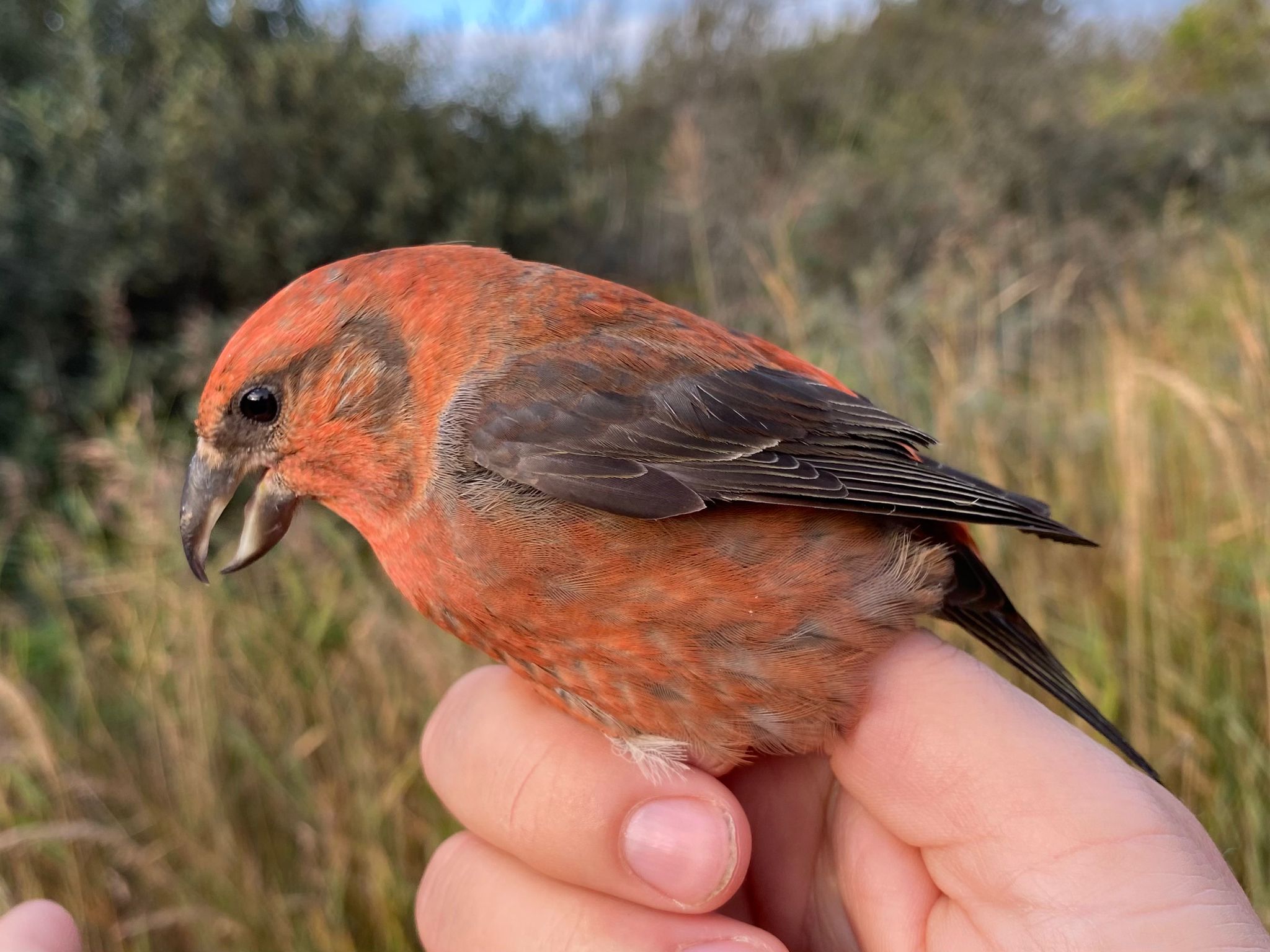 Lille korsnæb han ringmærket ved Kabeltromlen
Lille korsnæb han ringmærket ved Kabeltromlen
Dagens trækobs blev gjort fra Verdens ende 3, og bød på mange måger og suler der gjorde det svært at observere andre fugle. Dog blev der set rider samt almindelig kjove og en enkelt kjove der ikke kunne identificeres. Derudover blev der også forsøgt at aflæse farveringe af splitterner, men de viste sig at være lidt udfordrende at aflæse bl.a. pga. deres korte ben og en anderledes type af farveringe der var blevet brugt på disse. Derimod fik to svartbage aflæst deres ringe og der blev også igen set en interessant ”gul vipstjerte-type” dog kun for et kort øjeblik. Der blev også set to mursejlere der muligvis kunne være sæsonens allersidste. 6 sølvhejrer lagde også deres vej forbi, samt en dværgmåge og nogle tejst.
 Lille gråsisken han ringmærket ved Kabeltromlen
Lille gråsisken han ringmærket ved Kabeltromlen
Om eftermiddagen var der planlagt periodisk rengøring af feltstationen samt bolig. Efterfølgende havde vi et kort seminar om etik mht. ringmærkning hvor vi gennemgik de overvejelser og hensyn der skal tages ifm. ringmærkning af fugle, og vendte forskellige casestories og personlige anekdoter. Aftenen blev sluttet af med et spil bordtennis.
Ringmærkning (Kabeltromlen):
Munk 9
Gransanger 6
Rødhals 2
Rødstjert 1
Lille gråsisken 1
Sortmejse 1
Solsort 1
Rørsanger 1
Tornsanger 2
Lille dompap 1
Lille korsnæb 1
Total: 26
Ringmærkning (Jennes Sø):
Jernspurv 1
Rødhals 2
Munk 2
Gransanger 6
Løvsanger 1
Broget fluesnapper 1
Blåmejse 5
Total: 6
Bemærkelsesværdige observationer (Verdens Ende 3):
Mursejlere 2
Sølvhejrer 6
Dværgmåge 1
Tejst 3
Today’s observations in Dofbasen from observers in the area
Personer: Lisa Vergin, Gabriel Axelsson, Florian Hatt, Selina Veng, Janna Ouedraogo, Sarah Partridge, Óscar Pachá Guerras, Knud Pedersen, Simon Christiansen, Michael Ancher.
Rarities & Rainbows
Today we have some exciting belated news to share with you!
On 10th of August this year, Simon Kiesé spotted an interesting tern at Grenen. After extensive analysis, it is now clear that it was a Roseate tern (Rosenterne)! Here you can find photos und a video of this beauty.
Furthermore, we can announce that a Citrine Wagtail (Citronvipstjert) showed up at Grenen yesterday! We have updated yesterday's blog, so you can find more details about the bird there.
Enough about the past, let's talk about today.
Janna, Gabriel and I were stationed at Verdens Ende III again, where Knud joined us shortly after our arrival. Today we counted nice numbers of migrating Teals (Krikand) and Wigeons (Pibeand) and got good views on a flock of Light-bellied Brent Geese (ssp. hrota) (Lysbuget Knortegås). This subspecies was actually a lifer for me! But it shouldn't be the only one today. Stay tuned!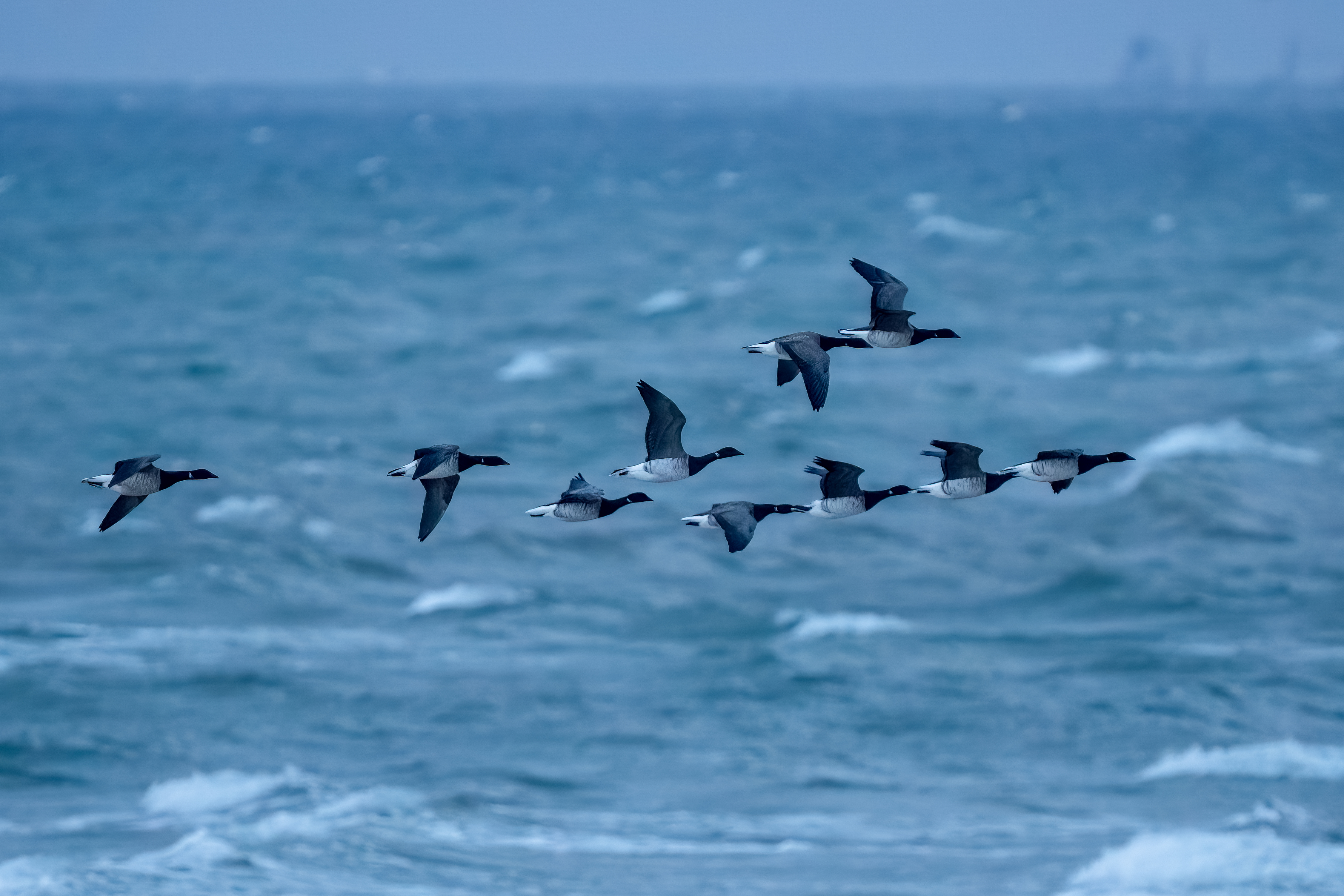
Flock of Light-bellied Brent Geese (Lysbuget Knortegås)
In fantastic light, we saw a big flock of Gannets (Sule) foraging. We counted 581 resting individuals today! 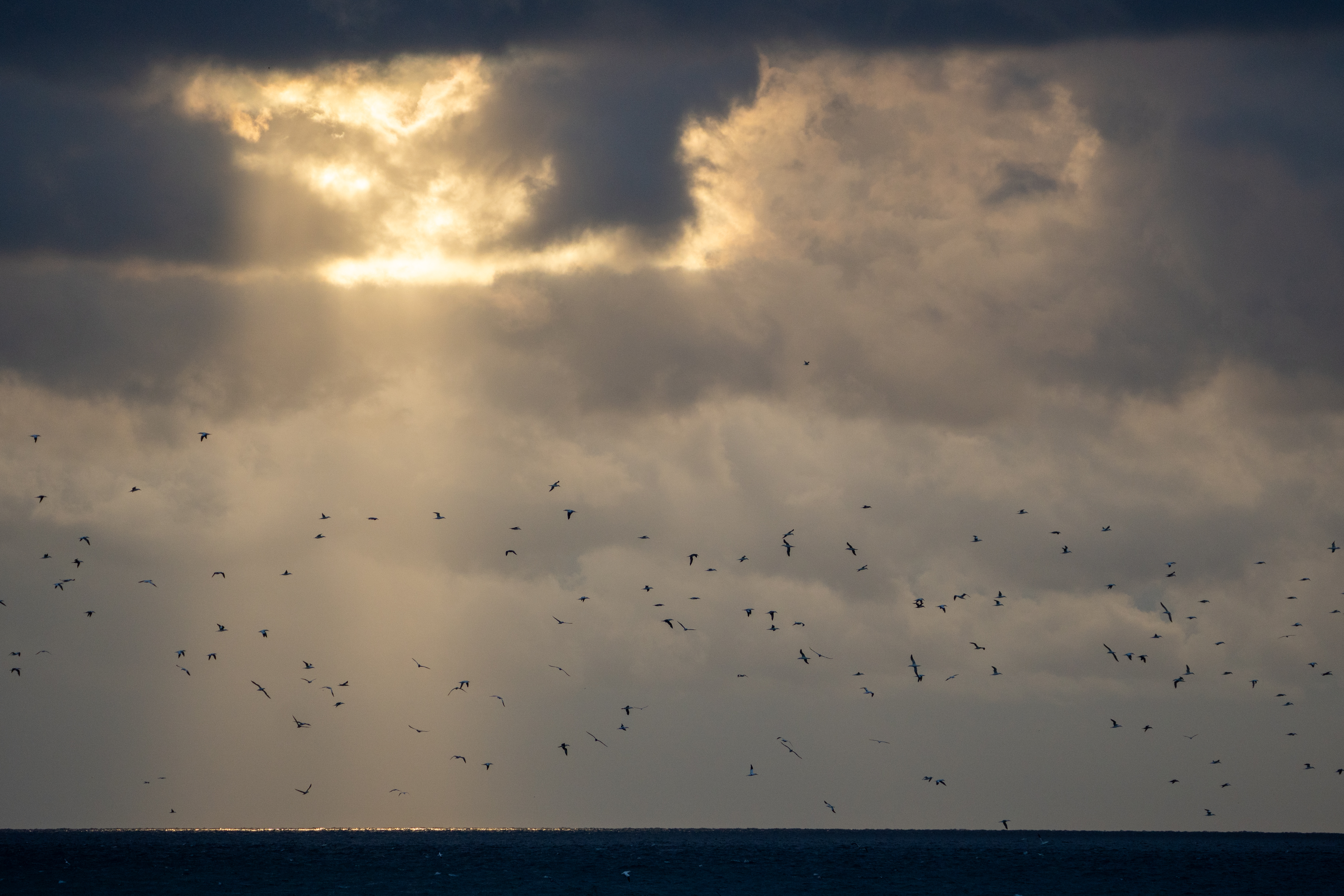
Huge flock of Gannets (Sule) in magic light
As in the days before we managed to spot some Arctic skuas (Almindelig Kjove). But one far distant bird looked a bit different. Thanks to the many years of experience Knud has, we were able to identify the bird as a Long-tailed skua (Lille Kjove)! But things only got better today. It didn't take long before Knud said: “Sooty shearwater flying northwest!” Sodfarvet Skråpe would be the next lifer for me and for Janna too! And indeed: we all saw the shearwater surfing through the waves. They are fantastic flyers and just amazing birds! As if that weren't enough, a short time later Janna spotted a small falcon flying out to sea. Even through the binoculars we could clearly see: It's a juvenile Red-footed falcon (Aftenfalk)! We were able to follow the little fellow for a long time as he flew further and further out until we finally lost sight of him in the far distance.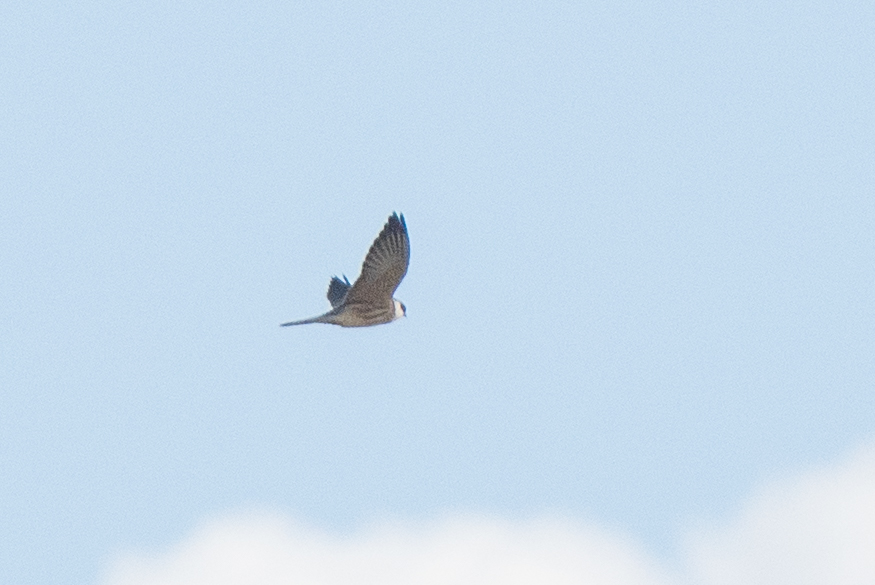
Juvenile Red-footed falcon (Aftenfalk) migrating out to the sea
As a little treat on the way back, we saw a White-tailed eagle (Havørn). The ringers at Kabeltromlen were even able to watch two individuals performing some acrobatics in the air.
The ringing was also quite successful today with lots of birds, especially in the first round. The highlight was a handful of Pied flycatchers (Broget fluesnapper) today!
After lunch, Simon gave us a lesson on the moulting strategies of passerines. For some of us, it was more of a repetition, but for me, there is still much to learn.
While working comfortably indoors in the afternoon, we were able to enjoy the sight of a triple rainbow!
Only barely visible in the photo: the triple rainbow
To round off the day, we enjoyed a delicious dinner of tarte flambée, which Janna had made for us!
Ringing (Kabeltromlen)
Gærdesmutte 1
Sortmejse 9
Løvsanger 3
Rødhals 4
Rørsanger 1
Jernspurv 1
Broget fluesnapper 5
Rødstjert 5
Munk 10
Blåmejse 2
Gransanger 4
Lille Dompap 1
Total: 46
Highlights from World’s End 3
Lille Kjove
Sodfarvet Skråpe
Aftenfalk
Today’s observations in Dofbasen from observers in the area
People: Gabriel Axelsson, Florian Hatt, Selina Veng, Janna Ouedraogo, Sarah Partridge, Óscar Pachá Guerras, Knud Pedersen, Simon Christiansen.
Good luck my little friend
This morning was raining when we woke up to leave for work, so we all got to sleep for another hour or so and then spent a pleasant morning drinking coffee together around the table and chatting. When it cleared up a bit, I went to World’s End III with Janna and Florian for the last two hours of the standardized count. We had a nice time looking at many migrating scoters (Sortand), plenty of shorebirds on the beach (Sandløber, Stor præstekrave, Islandsk ryle), and one very cute Dværgryle. We also saw three types of auks (Lomvie, Alk, and Tjest), which was very nice, as well as two arctic skuas (Almindelig Kjove), one of which was a very fine adult light morph that was close to shore and flying slowly in the wind so we got a good look at it. Florian also spotted a strange wagtail from which he got some low-quality photos and recordings of. Back home we realised it could be an Eastern Yellow Wagtail (Østlig Gul Vipstjert)! He went back out this evening to find it again and in Florian fashion found it immediately and took nice photos and recordings. It turned out that the bird was a Citrine wagtail (Citronvipstjert)! What a nice rarity and not often seen in autumn!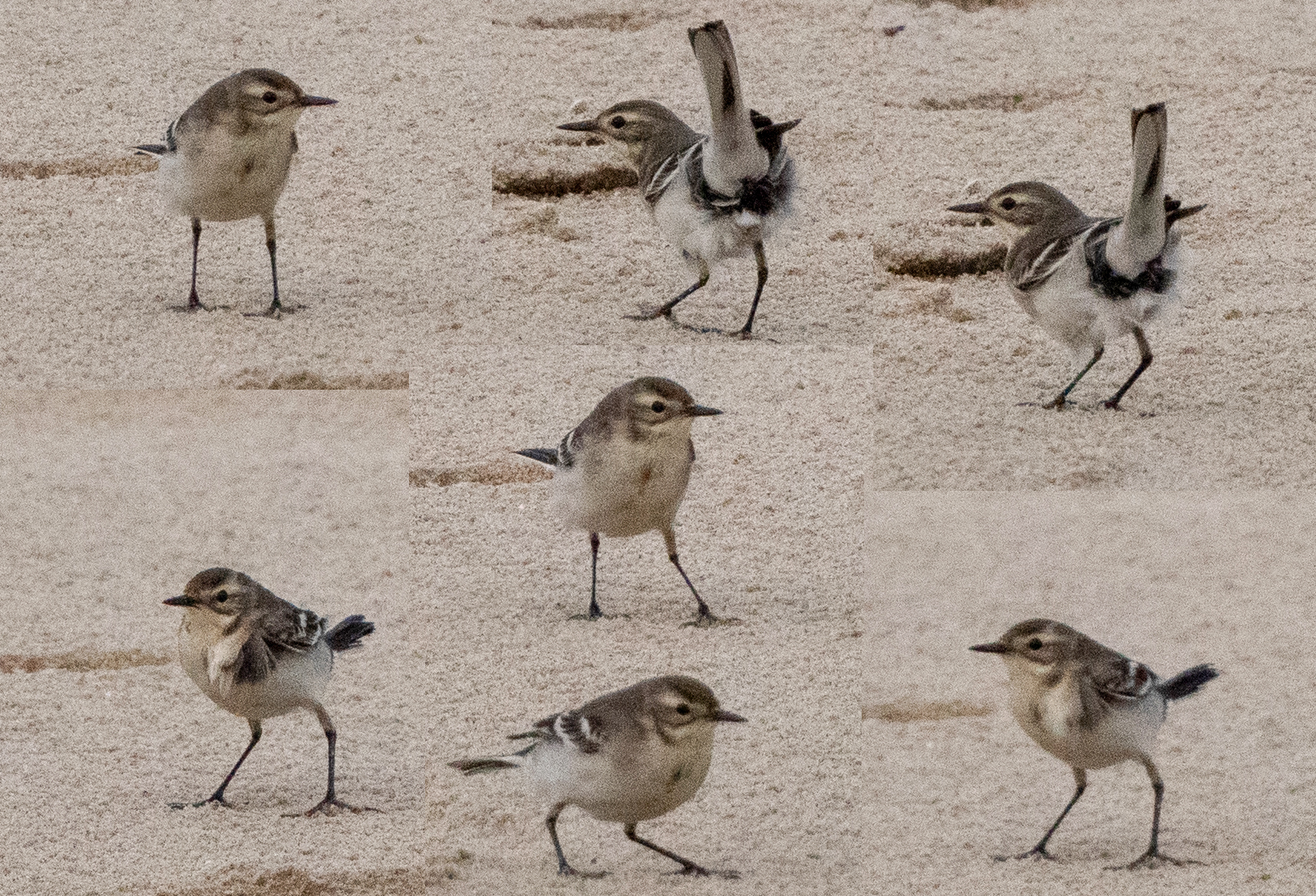
A collage of photos of the citrine wagtail taken in the evening
Clean sound recording from the evening
We stayed a little bit after the count to seawatch some more, and then I went down onto the beach to read some gull colour rings.
Meanwhile, Selina, Gabriel and Oscar met Simon at Kabeltromlen for ringing. There they were excitde to see one Isfugl (Kingfisher) and also managed to get a nice recording (Link here). It was very slow and they considered closing the nets when they found a Wryneck (Vendehals) in the net, the first of the year and probably the last. Lisa, Janna and Florian heeded the Zello call, which I missed, but luckily I decided to stop by anyway to see if they caught anything, so we all met at Kabeltromlen and got to see this absolutely stunning bird. We also got to see it twisting its neck in the way that originally got the bird its English name! Also a colloquial term for Torticollis (a human medical condition), “Wryneck” means a neck that is bent, twisted, or distorted at an odd angle. “Wry” as an adjective was used in the 16th century when the bird was first described in English, coming from the Middle English “wrien,” Old English “wrigian,” from the Proto-Germanic root “wrig” meaning to turn, bend, twist, go. The verb form of the word is long since obsolete, and the adjective is not often used, but the word remains in the name of the bird and the human neck condition. The name of the genus, Jynx, comes from the ancient Greek Iynx, which was the name for Wryneck that came from a mythological story. Iynx was a nymph who attempted to charm Zeus himself with magic, and for this crime Hera turned her into a bird (Iynx/Wryneck). The bird became a symbol of passionate and restless love, and iunx wheels, ceramic discs decorated with Wrynecks, were sold as magical love charms (or possibly as children’s toys).
Now back to the bird. A relative of woodpeckers, Wrynecks are most well known for their tendency to twist the neck and hiss when threatened, thought to be an imitation of a snake to scare potential predators. These sensual symbols of love enjoy feasting on insects that they capture with their sticky tongues. As a long-distance migrant, this lonely lover will be on its way to Africa for winter, and it has already cultivated plenty of fat for the journey. Good luck my little friend.
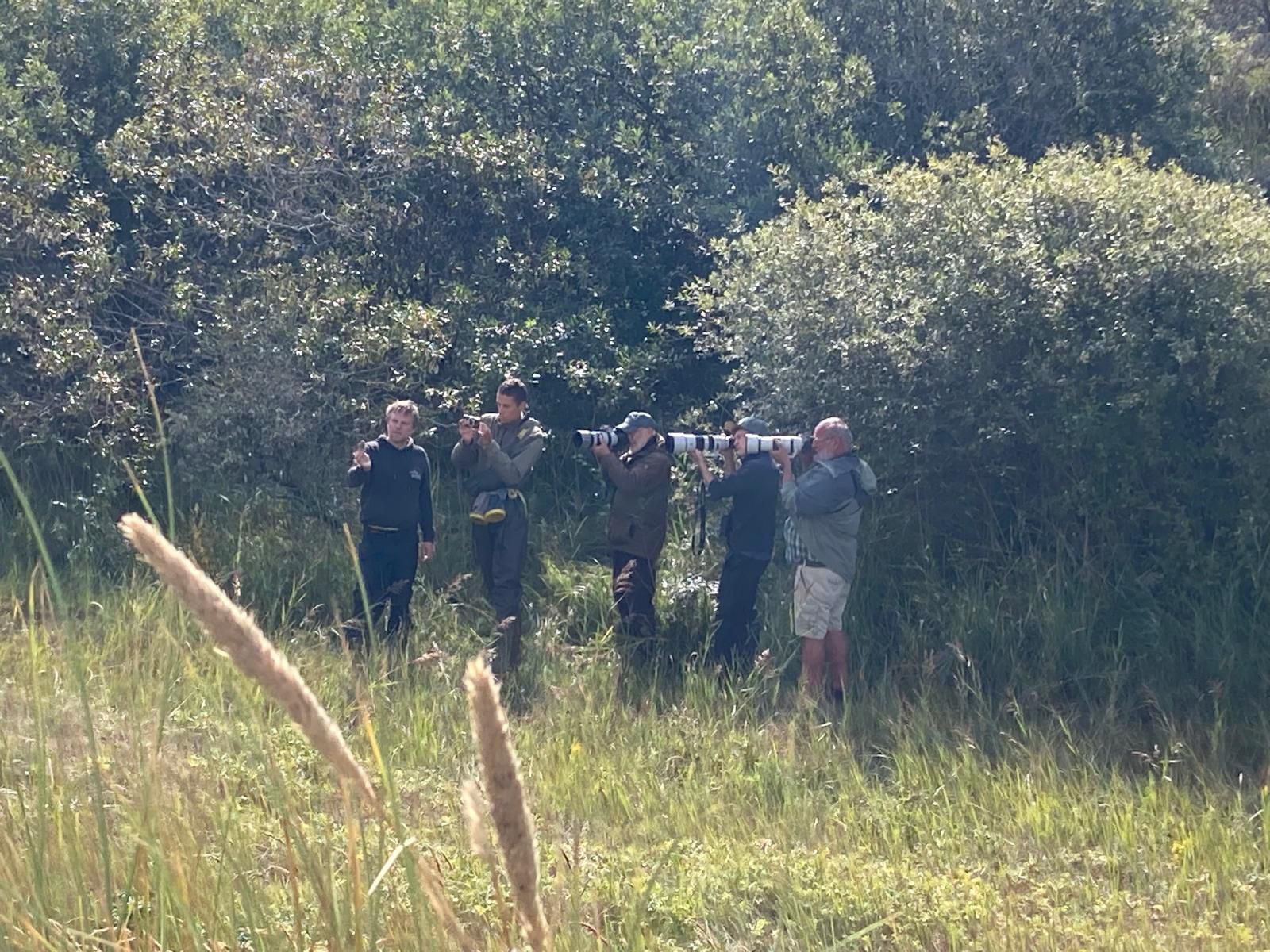

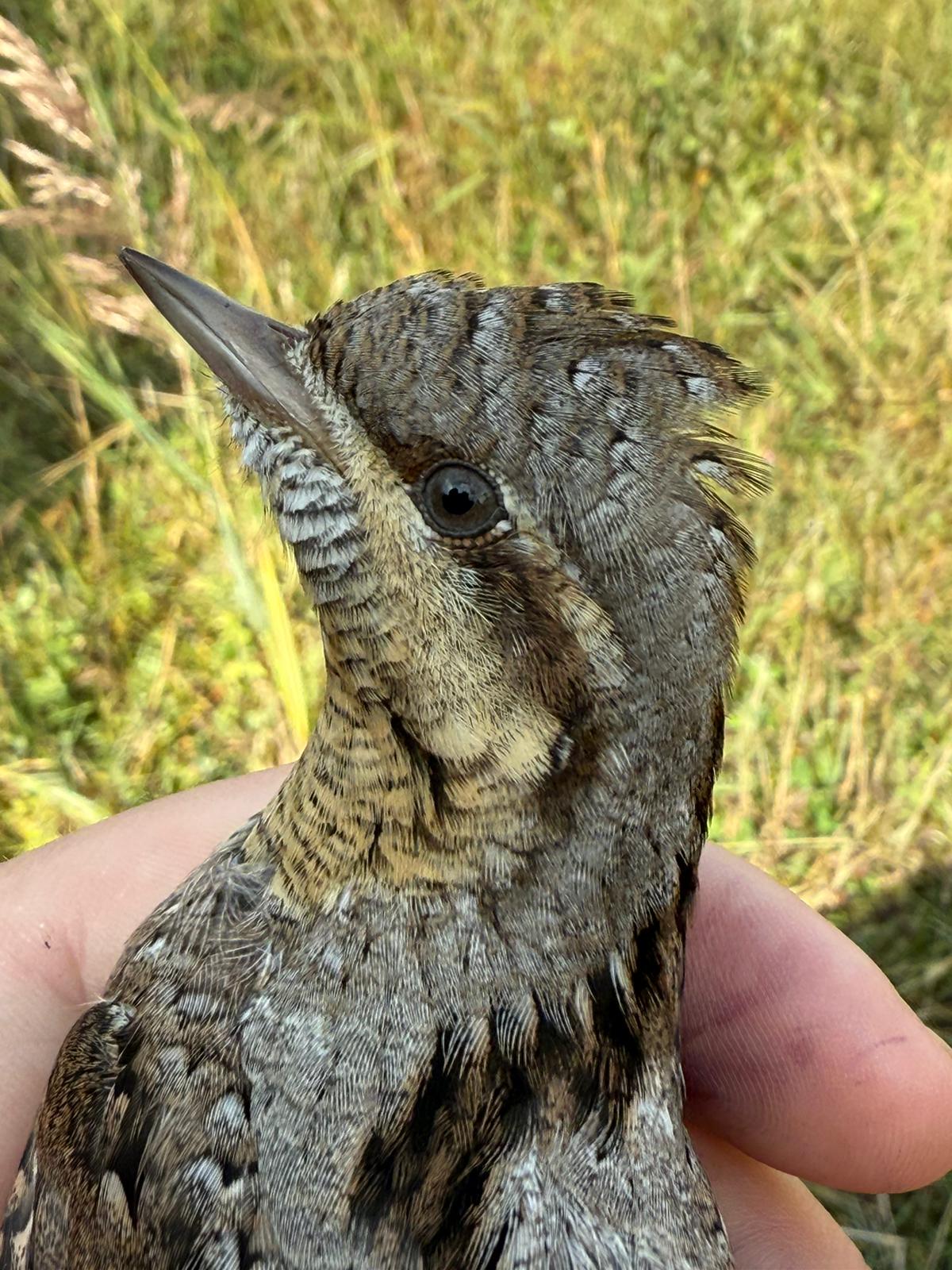 Ringing KAB
Ringing KAB
Munk 6
Sortmejse 5
Jernspurv 1
Rørsanger 1
Vendehals 1
Total: 14
Highlights from observation:
Citronvipstjert, Almindelig Kjove, Sandløber, Stor præstekrave, Islandsk ryle, Dværgryle
People: Gabriel Axelsson, Florian Hatt, Selina Veng, Janna Ouedraogo, Sarah Partridge, Óscar Pachá Guerras, Knud Pedersen, Lisa Vergin, Simon Christiansen.
Today’s observations in Dofbasen from observers in the area can be found here.
